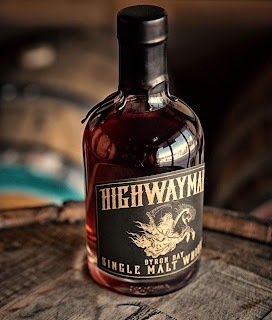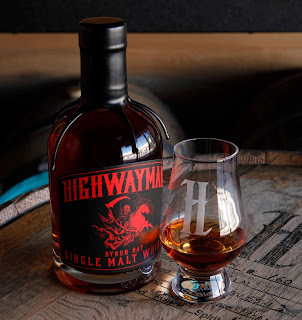I know, that's a terrible title, but I promise it's not my fault! As you'll see from the label below, the proprietor of this new independent bottling is testing the limits of how many times the word "whisky" can appear on a bottle of whisky!
This new arrival is an independent bottling of single malt Scotch whisky, sourced and bottled for the organisers of the annual Brisbane whisky show / event dubbed "Whisky Whisky". In a fit of madness - possibly after many, many drams - head honcho Shaun decided to both label & brand his independent bottling as "Whisky by Whisky Whisky". I'm still cringing each time I type the words, but I'll get over it. Maybe. Anyway, nomenclature aside this is a single cask bottling that is exclusive to Australia, bottled at cask strength from a refill ex-bourbon cask without any added colouring or chill filtration. This first bottling is from the Highland region, but that's as much information as you'll find on the label. It's not much of a mystery to those "in the know" since the this Highlander is peated, which leaves a few options, but only a couple that are realistic possibilities for a small independent bottler right out of the gate. Shaun's asked me not to name the distillery involved, and he didn't tell me in the first place, rather I pieced it together in around 2-seconds flat, and I'm sure many readers will. I'll also tease you with the fact that I'm not a huge fan of this distillery, particularly in their official bottlings but also in many independent examples. It's just not a name I'd normally reach for. Yes I should know better, but I can't drink 'em all! That said, I have come across a couple of excellent independent examples over the years, and yes, this particular cask is a winner. Considering that this is the first foray of "Whisky by Whisky Whisky" (sorry, still cringing) in the arena of independent bottlings, they've set the bar quite high!
Whisky Whisky is an annual whisky event in turn organised by Brisbane-based whisky club Supping Club, who hold monthly social catch-ups for dinner & drams. Whisky Whisky is a more casual affair than the likes of Whisky Live or the QLD Malt Whisky Expo; it's actually held outdoors, under cover thankfully (although Shaun has placed yours truly in the path of blaring sunlight for two years in a row now. Hmm...), and has a growing following and a great list of both small & large vendors presenting their wares. So how & why did this lawyer by trade go from organising relatively small whisky & spirits events in Brisbane, Australia, to becoming an independent bottler of single malt Scotch whisky? That came about through Will Pitchforth, who looks after commercial operations for Bladnoch Distillery from Australia, and dabbles in independent bottling & cask brokering in his spare time. Who wouldn't jump at this chance if it was presented to them!
Starting with a cask strength, single cask peated single malt is a great sign for the future of this little outfit. This is a peated single malt Scotch whisky from the Highland region, and it's from the mainland rather than the islands. That only really leaves a few distilleries as viable options; Edradour's Ballechin, Glenturret, Loch Lomond, or Ben Nevis, discounting newcomers Ardnamurchan and Wolfburn, who as far as I'm aware aren't selling casks externally. But there's one more distillery that is owned by a large Japanese corporation, and doesn't appear very often in official bottlings - and is usually lacklustre when it does - but is relatively easy to find in independent bottlings. Being a mainland operation this distillery's style of peat influence is quite distinctive, being more earthy & leathery rather than peaty & smoky like you'd expect from the big brands of peated malts. Then again this spirit does often find its way into refill casks that were previously used at a sister distillery over on Islay, although I don't think that's been the case here. This is an 8-year old refill bourbon barrel, bottled at a cask strength of 57.3% ABV and in 750ml bottles - that's right, 750ml bottles here in Australia, take that America! There are only 200 bottles available, and pricing is going to be quite reasonable at $199 AUD for Supping Club members, and $229 for general sale. For those playing overseas this is about the going rate for a cask strength single cask in Australia, so this is a reasonable offer. This whisky officially launched this week, November the 25th to be exact, so it's available here (Australia only) and probably won't last long. Let's get into it!
"A Whisky by Whisky Whisky" Cask #001, 8-year old, 57.3%. Highlands, Scotland.
Peated single malt distilled at unnamed distillery in the Highlands region. Matured in a refill ex-bourbon barrel. Non-chill filtered, natural colour. 200 bottles.
Colour: Pale gold.
Nose: Sweet pastry (e.g. pie crust), soft ashy smoke, and lovely dry maltiness. Old coarse leather, touch of dry earthy peat, hot wood embers. Slight hints of yeasty acidity & floral spirit (acetone) around the edges, with touches green chilli flakes & under-ripe banana.
Texture: Medium weight. Builds quickly. Earthy & dry, malty & smoky. Slight touch of heat but it's well-integrated.
Taste: More sweet pastry / pie crust, dry, ashy smoke with some vanilla bean & chilled butter underneath. Growing earthy peat & dry spiciness (smoked chilli flakes this time) heading into the finish.
Finish: Medium length. Malty & earthy, slight touch of acetone, then that big leathery, spicy, dry & smoky punch comes back through. Hints of peanut butter & chilli chocolate, then black pepper, malt, and old leather to finish.
Score: 3.5 out of 5.
Notes: There's really no mistaking this distillery, especially when it's presented at a young age and in a refill cask so the spirit character shows through. This cask is certainly youthful & spirit driven, but it carries itself well with lovely doses of dry earthy peat, coarse old leather, soft smoke & dry maltiness. And that's exactly what you want from this Highland distillery, which shall remain nameless. It's quite a unique flavour profile that is almost completely neglected by the distillery owners, and if you've only tried their ~$60 NAS bottling you'll be hard-pressed to recognise the distillery character in it - but that's entirely the fault of the lacklustre official bottling, and not the independents. I get the impression that they only keep it running for the sake of Teacher's, to the point where they now make a high proportion of unpeated spirit there that is destined to become blend filler. Which is a shame, but we have to remember that blends are still the name of the game for all of the larger corporations. Thankfully we have independent bottlers to save some of the good examples before they're blended into oblivion!
This is a great example of that situation, even if the distillery shall remain nameless. Well done Shaun & team on this first independent bottling!
Cheers!













